Tribological Performance for Steel–Steel Contact Interfaces Using Hybrid MWCNTs/Al2O3 Nanoparticles as Oil-Based Additives in Engines
Abstract
1. Introduction
2. Materials and Experimental Setup
3. Results and Discussions
3.1. Influence of Al2O3/MWCNTs on Kinematic Viscosity
3.2. Influence of Al2O3/MWCNTs on the Coefficient of Friction
3.3. Influence of Al2O3/MWCNTs on the Wear Rate
3.4. Influence of Al2O3/MWCNTs on Worn Surfaces
3.5. Influence of Al2O3/MWCNTs on Topography
4. Conclusions
Author Contributions
Funding
Data Availability Statement
Conflicts of Interest
References
- Ali, M.K.A.; Xianjun, H. Improving the tribological behavior of internal combustion engines via the addition of nanoparticles to engine oils. Nanotechnol. Rev. 2015, 4, 347–358. [Google Scholar] [CrossRef]
- Srivyas, P.; Charoo, M. A Review on Tribological Characterization of Lubricants with Nano Additives for Automotive Applications. Tribol. Ind. 2018, 40, 594–623. [Google Scholar] [CrossRef]
- Wang, B.; Qiu, F.; Barber, G.C.; Zou, Q.; Wang, J.; Guo, S.; Yuan, Y.; Jiang, Q. Role of nano-sized materials as lubricant additives in friction and wear reduction: A review. Wear 2022, 490, 204206. [Google Scholar] [CrossRef]
- Ahmed, E.; Nabhan, A.; Ghazaly, N.M.; el Jaber, G.T.A. Tribological Behavior of Adding Nano Oxides Materials to Lithium Grease: A Review. Am. J. Nanomater. 2020, 8, 1–9. [Google Scholar]
- Jason, Y.; How, H.; Teoh, Y.; Chuah, H. A Study on the Tribological Performance of Nanolubricants. Processes 2020, 8, 1372. [Google Scholar] [CrossRef]
- Lawrence, K.D.; Ramamoorthy, B. Multi-surface topography targeted plateau honing for the processing of cylinder liner surfaces of automotive engines. Appl. Surf. Sci. 2016, 365, 19–30. [Google Scholar] [CrossRef]
- Mortier, R.M.; Orszulik, S.T.; Fox, M.F. Chemistry and Technology of Lubricant; Springer: Berlin/Heidelberg, Germany, 2010; Volume 107115. [Google Scholar]
- Mang, T.; Dresel, W. Lubricants and Lubrication; John Wiley & Sons: Hoboken, NJ, USA, 2007. [Google Scholar]
- Bhushan, B.; Luo, D.; Schricker, S.R.; Sigmund, W.; Zauscher, S. Handbook of Nanomaterials Properties; Springer Science & Business Media: Berlin/Heidelberg, Germany, 2014. [Google Scholar]
- Asha, A.B.; Narain, R. Nanomaterials properties. In Polymer Science and Nanotechnology; Elsevier: Amsterdam, The Netherlands, 2020; pp. 343–359. [Google Scholar]
- Vollath, D. Nanomaterials an introduction to synthesis, properties and application. Environ. Eng. Manag. J. 2008, 7, 865–870. [Google Scholar]
- Kotia, A.; Rajkhowa, P.; Rao, G.S.; Ghosh, S.K. Thermophysical and tribological properties of nanolubricants: A review. Heat Mass Transf. 2018, 54, 3493–3508. [Google Scholar] [CrossRef]
- Ilie, F.; Covaliu, C. Tribological Properties of the Lubricant Containing Titanium Dioxide Nanoparticles as an Additive. Lubricants 2016, 4, 12. [Google Scholar] [CrossRef]
- Nabhan, A.; Rashed, A.; Ghazaly, N.M.; Abdo, J.; Haneef, M.D. Tribological properties of Al2O3 nanoparticles as lithium grease additives. Lubricants 2021, 9, 9. [Google Scholar] [CrossRef]
- Chen, B.; Liu, L.; Zhang, C.; Zhang, S.; Zhang, Y.; Zhang, P. Tribological Properties and Lubrication Mechanism of Protic Ionic Liquid-modified Nanosilica as High-temperature Antiwear Additive for Pentaerythritol Ester. Tribol. Int. 2022, 176, 107886. [Google Scholar] [CrossRef]
- Lijesh, K.P.; Muzakkir, S.M.; Hirani, H. Experimental tribological performance evaluation of nano lubricant using multi-walled carbon nano-tubes (MWCNT). Int. J. Appl. Eng. Res. 2015, 10, 14543–14550. [Google Scholar]
- Nabhan, A. Vibration analysis of adding contaminants particles and carbon nanotubes to lithium grease of ball bearing. Vibroengineering Procedia 2016, 8, 28–32. [Google Scholar]
- Singh, A.; Chauhan, P.; Mamatha, T. A review on tribological performance of lubricants with nanoparticles additives. Mater. Today Proc. 2020, 25, 586–591. [Google Scholar] [CrossRef]
- Pownraj, C.; Arasu, A.V. Effect of dispersing single and hybrid nanoparticles on tribological, thermo-physical, and stability characteristics of lubricants: A review. J. Therm. Anal. Calorim. 2021, 143, 1773–1809. [Google Scholar] [CrossRef]
- Zhang, W.; Demydov, D.; Jahan, M.P.; Mistry, K.; Erdemir, A.; Malshe, A.P. Fundamental understanding of the tribological and thermal behavior of Ag–MoS2 nanoparticle-based multi-component lubricating system. Wear 2012, 288, 9–16. [Google Scholar] [CrossRef]
- Ettefaghi, E.-O.; Ahmadi, H.; Rashidi, A.; Nouralishahi, A.; Mohtasebi, S.S. Preparation and thermal properties of oil-based nanofluid from multi-walled carbon nanotubes and engine oil as nano-lubricant. Int. Commun. Heat Mass Transf. 2013, 46, 142–147. [Google Scholar] [CrossRef]
- Lee, K.; Hwang, Y.; Cheong, S.; Kwon, L.; Kim, S.; Lee, J. Performance evaluation of nano-lubricants of fullerene nanoparticles in refrigeration mineral oil. Curr. Appl. Phys. 2009, 9, e128–e131. [Google Scholar] [CrossRef]
- Rasheed, A.; Khalid, M.; Javeed, A.; Rashmi, W.; Gupta, T.; Chan, A. Heat transfer and tribological performance of graphene nanolubricant in an internal combustion engine. Tribol. Int. 2016, 103, 504–515. [Google Scholar] [CrossRef]
- Ettefaghi, E.-O.; Rashidi, A.; Ahmadi, H.; Mohtasebi, S.S.; Pourkhalil, M. Thermal and rheological properties of oil-based nanofluids from different carbon nanostructures. Int. Commun. Heat Mass Transf. 2013, 48, 178–182. [Google Scholar] [CrossRef]
- Peng, Y.; Xu, Y.; Geng, J.; Dearn, K.D.; Hu, X. Tribological assessment of coated piston ring-cylinder liner contacts under bio-oil lubricated conditions. Tribol. Int. 2017, 107, 283–293. [Google Scholar] [CrossRef]
- Soleimani, M.; Bagheri, E.; Mosaddegh, P.; Rabiee, T.; Fakhar, A.; Sadeghi, M. Stable waterborne epoxy emulsions and the effect of silica nanoparticles on their coatings properties. Prog. Org. Coat. 2021, 156, 106250. [Google Scholar] [CrossRef]
- Bagheri, E.; Montazeri, R.; Bagheri, R. Effect of solid state ball milling on wear and structural properties of polytetrafluoroethylene/alumina nanocomposite coatings. Mater. Res. Express 2019, 6, 125315. [Google Scholar] [CrossRef]
- Tang, Z.; Li, S. A review of recent developments of friction modifiers for liquid lubricants (2007–present). Curr. Opin. Solid State Mater. Sci. 2014, 18, 119–139. [Google Scholar] [CrossRef]
- Lee, K.; Hwang, Y.; Cheong, S.; Choi, Y.; Kwon, L.; Lee, J.; Kim, S.H. Understanding the Role of Nanoparticles in Nano-oil Lubrication. Tribol. Lett. 2009, 35, 127–131. [Google Scholar] [CrossRef]
- Mousavi, S.B.; Heris, S.Z. Experimental investigation of ZnO nanoparticles effects on thermophysical and tribological properties of diesel oil. Int. J. Hydrogen Energy 2020, 45, 23603–23614. [Google Scholar] [CrossRef]
- Mousavi, S.B.; Heris, S.Z.; Estellé, P. Experimental comparison between ZnO and MoS2 nanoparticles as additives on performance of diesel oil-based nano lubricant. Sci. Rep. 2020, 10, 5813. [Google Scholar] [CrossRef]
- Kumar, V.P.S.; Subramanian, K.M.; Stalin, B.; Vairamuthu, J. Influence of ZnO nanoparticles on thermophysical and tribological properties of polyolester oil. Mater. Res. Express 2021, 8, 045502. [Google Scholar] [CrossRef]
- Xie, H.; Jiang, B.; He, J.; Xia, X.; Pan, F. Lubrication performance of MoS2 and SiO2 nanoparticles as lubricant additives in magnesium alloy-steel contacts. Tribol. Int. 2016, 93, 63–70. [Google Scholar] [CrossRef]
- Kotia, A.; Ghosh, G.K.; Srivastava, I.; Deval, P.; Ghosh, S.K. Mechanism for improvement of friction/wear by using Al2O3 and SiO2/Gear oil nanolubricants. J. Alloy Compd. 2019, 782, 592–599. [Google Scholar] [CrossRef]
- Umavathi, J.; Patil, S.L.; Mahanthesh, B.; Bég, O.A. Unsteady squeezing flow of a magnetized nano-lubricant between parallel disks with Robin boundary conditions. Proc. Inst. Mech. Eng. Part N J. Nanomater. Nanoeng. Nanosyst. 2021, 235, 67–81. [Google Scholar] [CrossRef]
- Amidu, M.A.; Addad, Y.; Riahi, M.K.; Abu-Nada, E. Numerical investigation of nanoparticles slip mechanisms impact on the natural convection heat transfer characteristics of nanofluids in an enclosure. Sci. Rep. 2021, 11, 15678. [Google Scholar] [CrossRef] [PubMed]
- Riahi, M.K.; Ali, M.; Addad, Y.; Abu-Nada, E. Combined Newton–Raphson and Streamlines-Upwind Petrov–Galerkin iterations for nanoparticles transport in buoyancy-driven flow. J. Eng. Math. 2022, 132, 22. [Google Scholar] [CrossRef]
- Rashed, A.; Nabhan, A. Effects of TiO2 and SiO2 nano additive to engine lubricant oils on tribological properties at different temperatures. In Proceedings of the 20th International Conference on Aerospace, Mechanical, Automotive and Materials Engineering, Rome, Italy, 19–20 September 2018; pp. 30–31. [Google Scholar]
- Nabhan, A.; Ghazaly, N.M.; Mousa, H.M.; Rashed, A. Influence of TiO2 and SiO2 Nanoparticles Additives on the Engine Oil Tribological Properties: Experimental Study at Different Operating Conditions. Int. J. Adv. Sci. Technol. 2020, 29, 845–855. [Google Scholar]
- Laad, M.; Jatti, V.K.S. Titanium oxide nanoparticles as additives in engine oil. J. King Saud Univ. Eng. Sci. 2018, 30, 116–122. [Google Scholar] [CrossRef]
- Birleanu, C.; Pustan, M.; Cioaza, M.; Molea, A.; Popa, F.; Contiu, G. Effect of TiO2 nanoparticles on the tribological properties of lubricating oil: An experimental investigation. Sci. Rep. 2022, 12, 5201. [Google Scholar] [CrossRef] [PubMed]
- Ahmed, E.; Nabhan, A.; Nouby, M.; el Jaber, G.T.A. Influence of Dispersing Lithium Grease by Hybrid Nano Titanium and Silicon Oxides on Friction Coefficient. J. Egypt. Soc. Tribol. EGTRIB J. 2018, 15, 61–71. [Google Scholar]
- Ma, S.Y.; Zheng, S.H.; Ding, H.Y.; Li, W. Anti-wear and reduce-friction ability of ZrO2/SiO2 self-lubricating composites. Adv. Mater. Res. 2009, 79, 1863–1866. [Google Scholar] [CrossRef]
- Sharma, A.K.; Tiwari, A.K.; Dixit, A.R.; Singh, R.K.; Singh, M. Novel uses of alumina/graphene hybrid nanoparticle additives for improved tribological properties of lubricant in turning operation. Tribol. Int. 2018, 119, 99–111. [Google Scholar] [CrossRef]
- Radhika, P.; Sobhan, C.; Chakravorti, S. Improved tribological behavior of lubricating oil dispersed with hybrid nanoparticles of functionalized carbon spheres and graphene nano platelets. Appl. Surf. Sci. 2021, 540, 148402. [Google Scholar] [CrossRef]
- Huang, S.; He, A.; Yun, J.-H.; Xu, X.; Jiang, Z.; Jiao, S.; Huang, H. Synergistic tribological performance of a water based lubricant using graphene oxide and alumina hybrid nanoparticles as additives. Tribol. Int. 2019, 135, 170–180. [Google Scholar] [CrossRef]
- Shi, S.-C.; Jiang, S.-Z. Influence of graphene/copper hybrid nanoparticle additives on tribological properties of solid cellulose lubricants. Surf. Coat. Technol. 2020, 389, 125655. [Google Scholar] [CrossRef]
- Zhang, Y.; Li, C.; Jia, D.; Zhang, D.; Zhang, X. Experimental evaluation of the lubrication performance of MoS2/CNT nanofluid for minimal quantity lubrication in Ni-based alloy grinding. Int. J. Mach. Tools Manuf. 2015, 99, 19–33. [Google Scholar] [CrossRef]
- Haldar, A.; Kotia, A.; Kumar, N.; Ghosh, S.K. Enhancing the tribological properties of hydraulic oil-based nanolubricants using MWCNT-SiO2 hybrid nanoparticles. J. Braz. Soc. Mech. Sci. Eng. 2022, 44, 223. [Google Scholar] [CrossRef]
- Bagheri, E.; Mosaddegh, P.; Behzad, T. Mechanical, thermal, and structural properties of uniaxially drawn polylactic acid/halloysite nanocomposites. J. Appl. Polym. Sci. 2020, 137, 49134. [Google Scholar] [CrossRef]
- Sharma, A.K.; Katiyar, J.K.; Bhaumik, S.; Roy, S. Influence of alumina/MWCNT hybrid nanoparticle additives on tribological properties of lubricants in turning operations. Friction 2019, 7, 153–168. [Google Scholar] [CrossRef]
- Esfe, M.H.; Esfandeh, S.; Alidoust, S.; Toghraie, D. Experimental study of rheological characteristics of MWCNT-Al2O3 (40:60)/SAE50 hybrid nano-lubricant to identify optimal lubrication conditions and post-processing of results using the response surface method. J. Mater. Res. Technol. 2021, 15, 2059–2074. [Google Scholar] [CrossRef]
- Esfe, M.H.; Alidoust, S.; Ardeshiri, E.M.; Kamyab, M.H.; Toghraie, D. Experimental Study of Rheological Behavior of MWCNT-Al2O3/SAE50 Hybrid Nanofluid to Provide the Best Nano-lubrication Conditions. Nanoscale Res. Lett. 2022, 17, 4. [Google Scholar] [CrossRef] [PubMed]
- Esfe, M.H.; Esfandeh, S.; Alidoust, S.; Toghraie, D. Comparison of viscosity behavior of hybrid nano-lubricants containing Al2O3-MWCNT nanoparticles dispersed in SAE XWX engine oils to determine the optimal behavior of nano-lubricants based on experimental studies. Colloids Surf. A Physicochem. Eng. Asp. 2022, 641, 128446. [Google Scholar] [CrossRef]
- Tadmor, R.; Rosensweig, R.E.; Frey, A.J.; Klein, J. Resolving the Puzzle of Ferrofluid Dispersants. Langmuir 2000, 16, 9117–9120. [Google Scholar] [CrossRef]
- Ranjbarzadeh, R.; Chaabane, R. Experimental Study of Thermal Properties and Dynamic Viscosity of Graphene Oxide/Oil Nano-Lubricant. Energies 2021, 14, 2886. [Google Scholar] [CrossRef]
- Kedzierski, M.A. Viscosity and density of CuO nanolubricant. Int. J. Refrig. 2012, 35, 1997–2002. [Google Scholar] [CrossRef]
- Goodarzi, M.; Toghraie, D.; Reiszadeh, M.; Afrand, M. Experimental evaluation of dynamic viscosity of ZnO–MWCNTs/engine oil hybrid nanolubricant based on changes in temperature and concentration. J. Therm. Anal. 2019, 136, 513–525. [Google Scholar] [CrossRef]
- Loehle, S.; Matta, C.; Minfray, C.; Le Mogne, T.; Martin, J.-M.; Iovine, R.; Obara, Y.; Miura, R.; Miyamoto, A. Mixed Lubrication with C18 Fatty Acids: Effect of Unsaturation. Tribol. Lett. 2013, 53, 319–328. [Google Scholar] [CrossRef]
- Dai, W.; Kheireddin, B.; Gao, H.; Liang, H. Roles of nanoparticles in oil lubrication. Tribol. Int. 2016, 102, 88–98. [Google Scholar] [CrossRef]
- Sharma, A.K.; Tiwari, A.K.; Dixit, A.R.; Singh, R.K. Measurement of machining forces and surface roughness in turning of AISI 304 steel using alumina-MWCNT hybrid nanoparticles enriched cutting fluid. Measurement 2020, 150, 107078. [Google Scholar] [CrossRef]
- Sahoo, B.; Chary, N.; Paul, J. Surface mechanical and self-lubricating properties of MWCNT impregnated aluminium surfaces. Surf. Eng. 2019, 35, 970–981. [Google Scholar] [CrossRef]
- Reinert, L.; Varenberg, M.; Mücklich, F.; Suárez, S. Dry friction and wear of self-lubricating carbon-nanotube-containing surfaces. Wear 2018, 406, 33–42. [Google Scholar] [CrossRef]
- Vardhaman, B.A.; Amarnath, M.; Ramkumar, J.; Mondal, K. Enhanced tribological performances of zinc oxide/MWCNTs hybrid nanomaterials as the effective lubricant additive in engine oil. Mater. Chem. Phys. 2020, 253, 123447. [Google Scholar] [CrossRef]
- Wu, H.; Jia, F.; Zhao, J.; Huang, S.; Wang, L.; Jiao, S.; Huang, H.; Jiang, Z. Effect of water-based nanolubricant containing nano-TiO2 on friction and wear behaviour of chrome steel at ambient and elevated temperatures. Wear 2019, 426, 792–804. [Google Scholar] [CrossRef]
- Mohamed, A.; Hamdy, M.; Bayoumi, M.; Osman, T. Synthesis and tribological properties of nanogrease. Ind. Lubr. Tribol. 2018, 70, 512–518. [Google Scholar] [CrossRef]
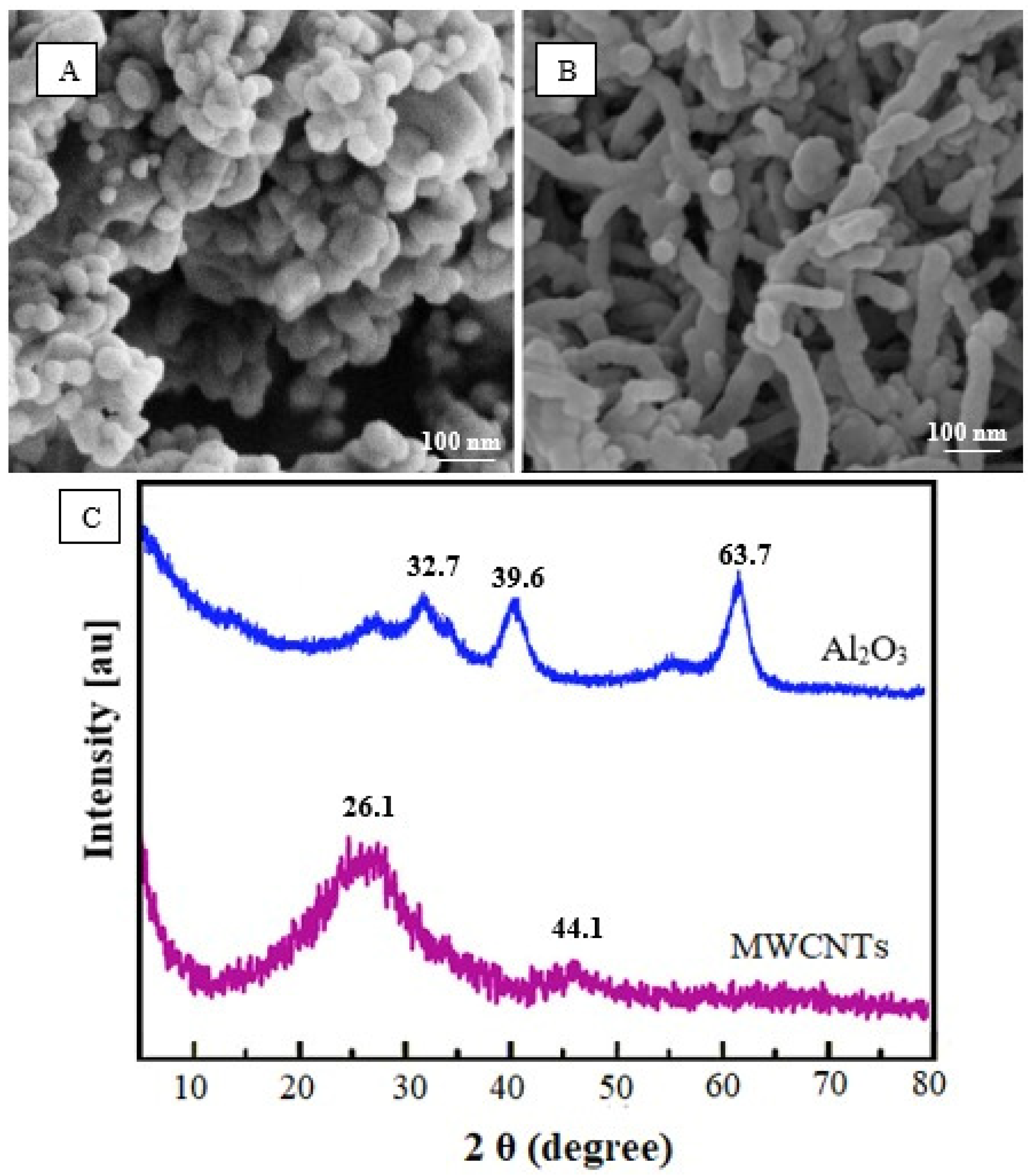
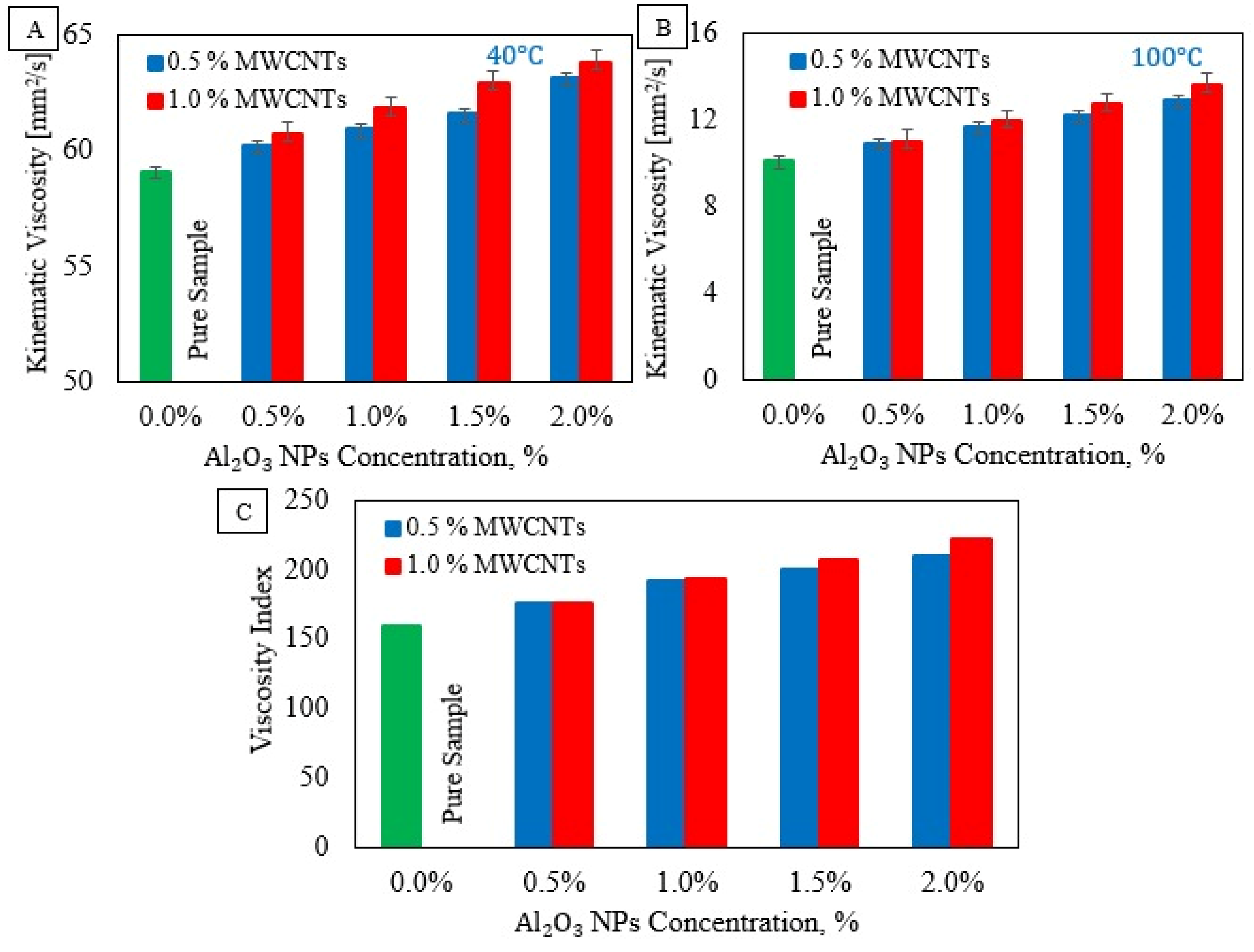
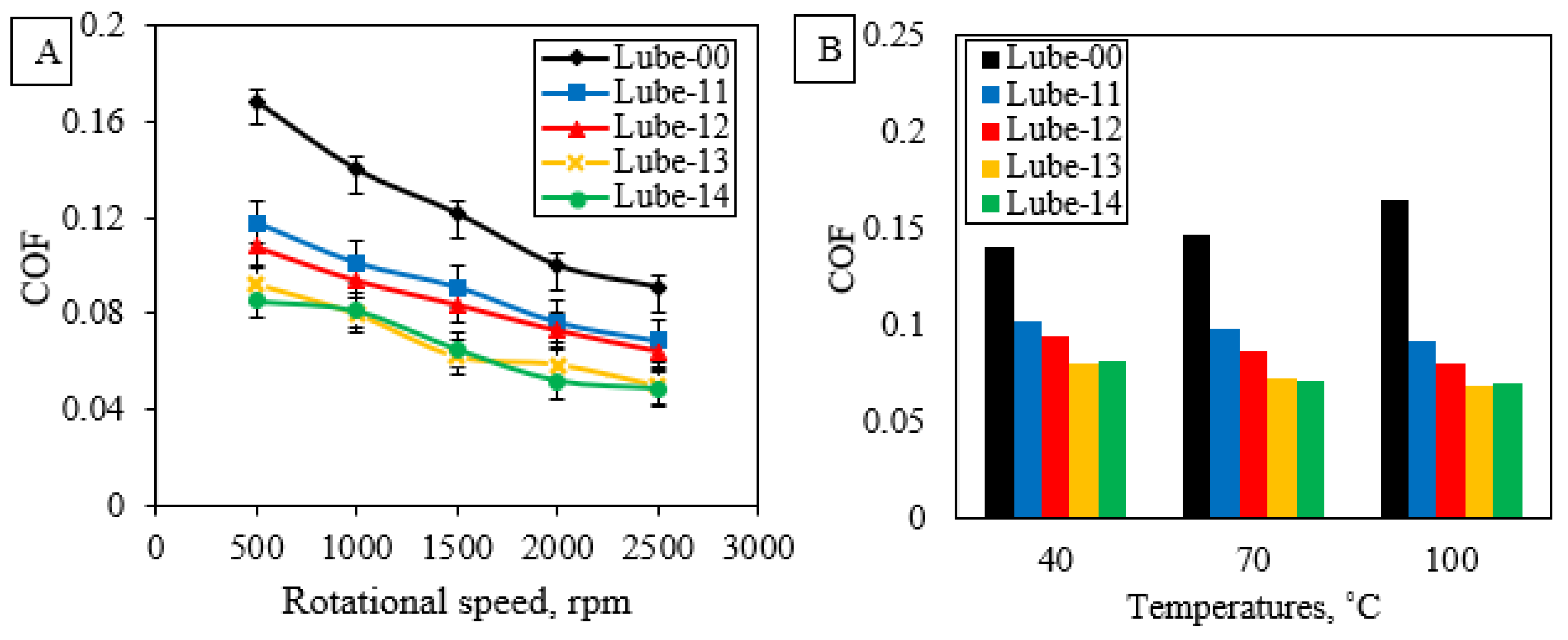
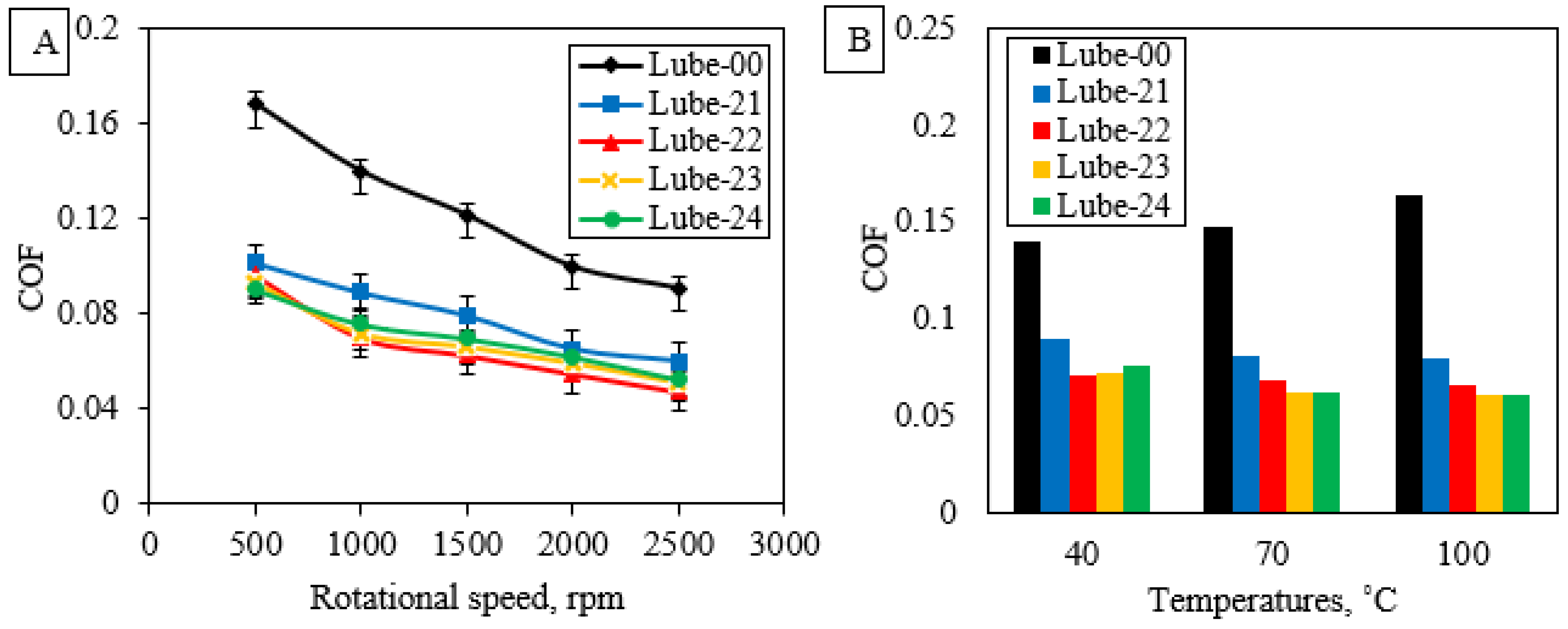
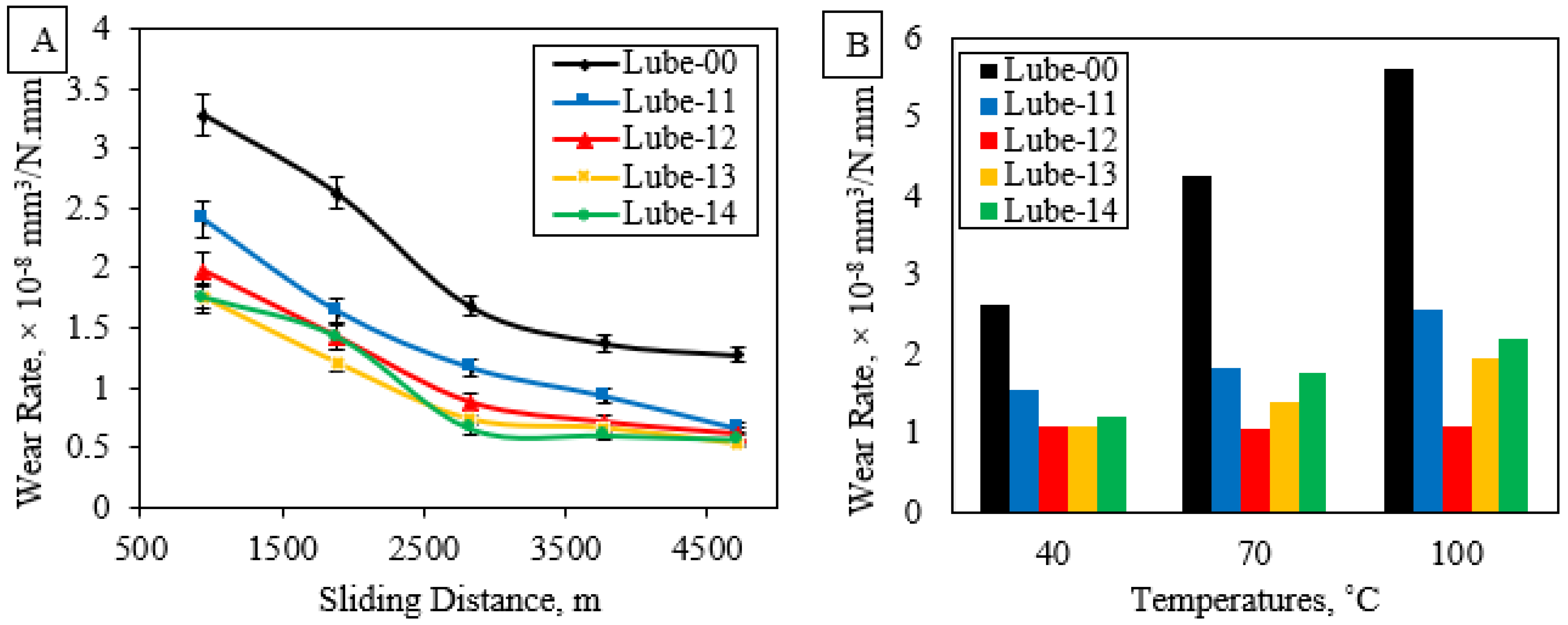
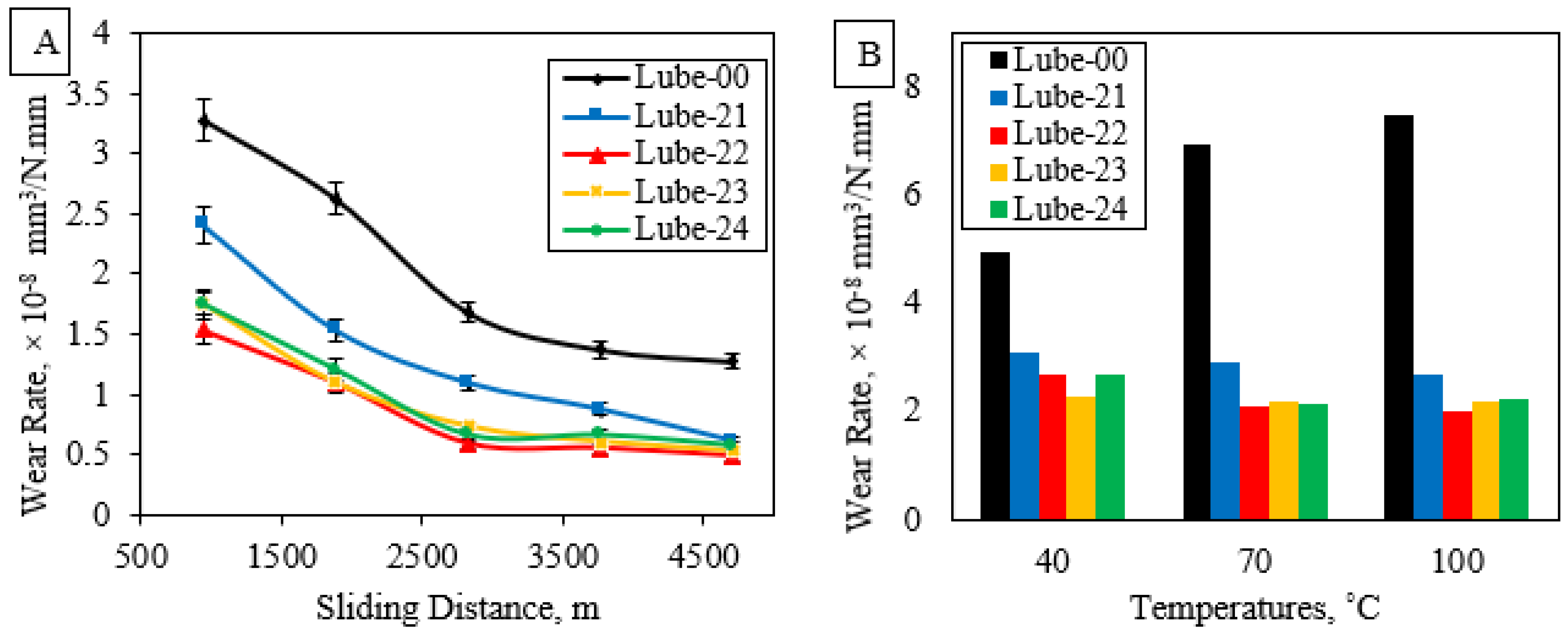
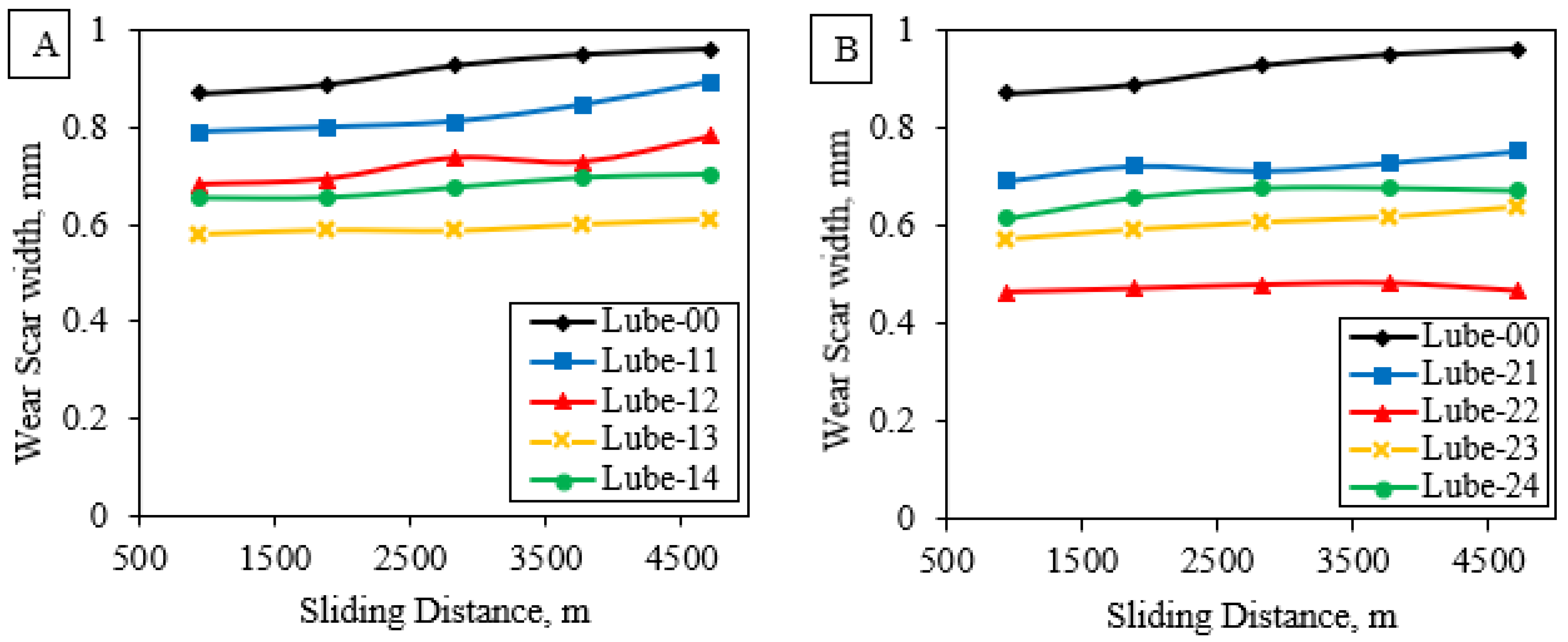
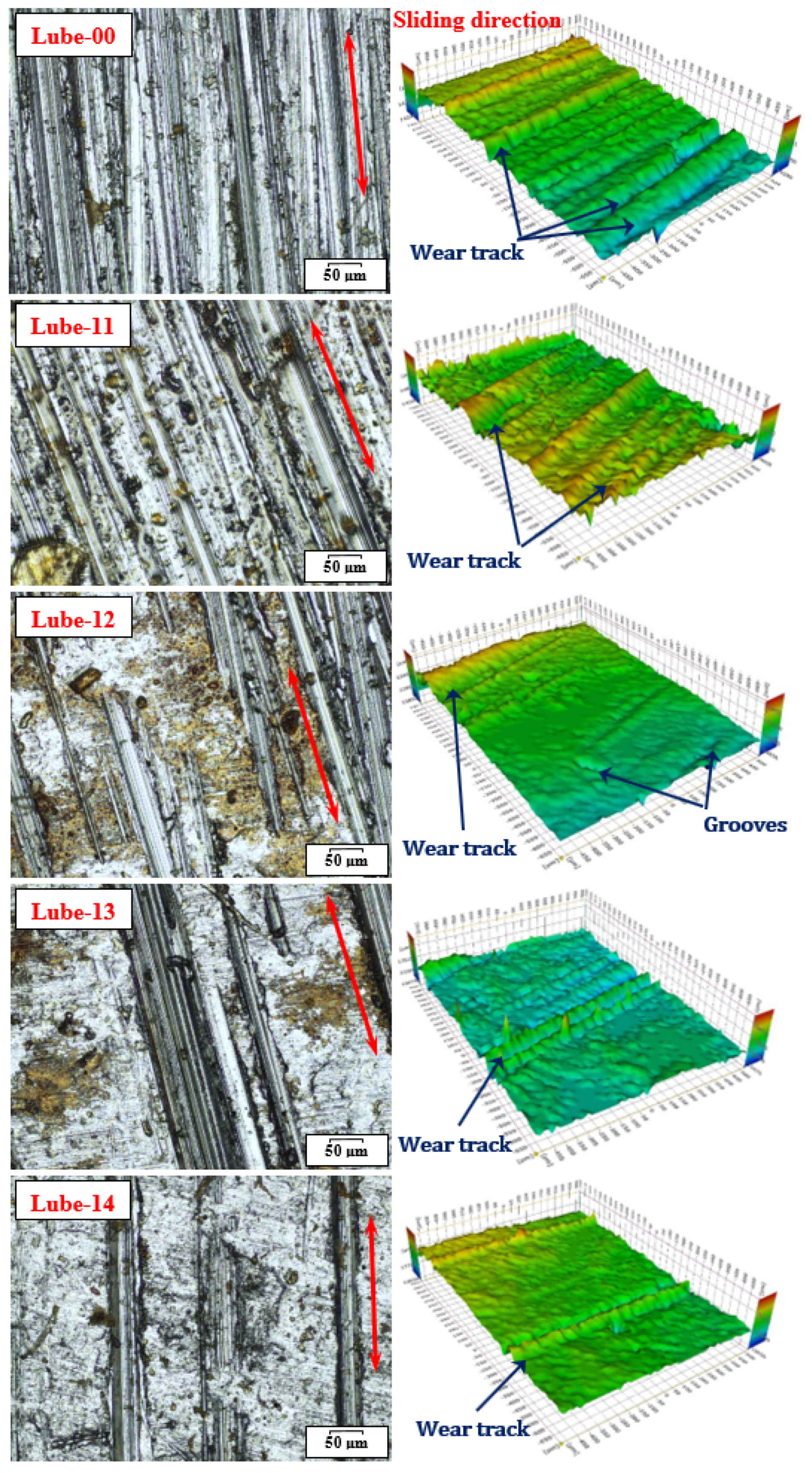

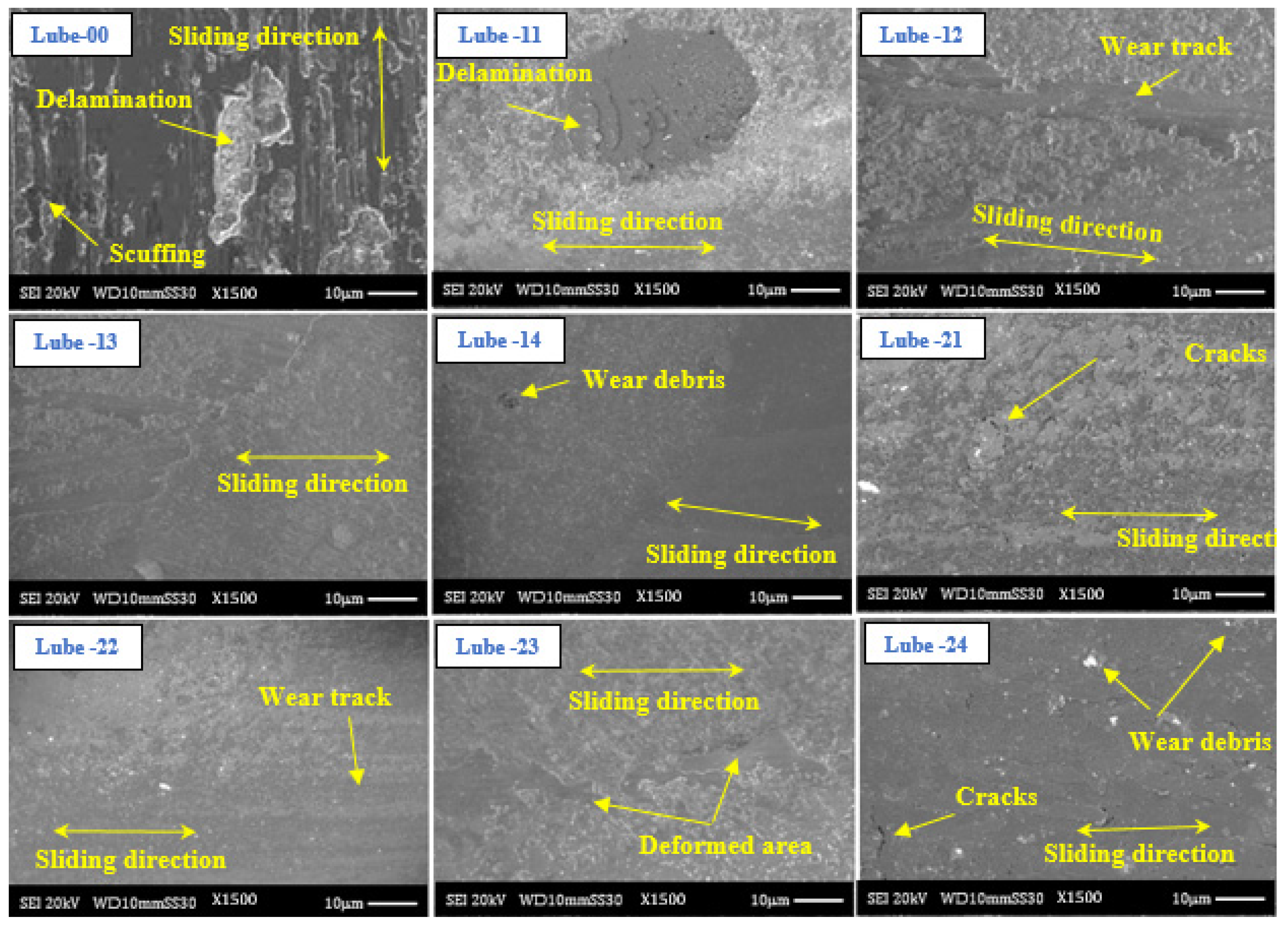
| Specifications | Value |
|---|---|
| Density (kg/L) | 0.862 |
| Viscosity index | 161 |
| Kinematic viscosity at 40 °C (mm2/s) | 60.5 |
| Kinematic viscosity at 100 °C (mm2/s) | 10.5 |
| Flash point (°C) | 226 |
| Pour point (°C) | −35 |
| Sample No. | Engine Oil | Oleic Acid | Al2O3 NPs | MWCNTs |
|---|---|---|---|---|
| Lube-00 | 100% | - | - | - |
| Lube-11 | 97.0% | 2% | 0.5% | 0.5% |
| Lube-12 | 96.5% | 2% | 1.0% | 0.5% |
| Lube-13 | 96.0% | 2% | 1.5% | 0.5% |
| Lube-14 | 95.5% | 2% | 2.0% | 0.5% |
| Lube-21 | 96.5% | 2% | 0.5% | 1.0% |
| Lube-22 | 96.0% | 2% | 1.0% | 1.0% |
| Lube-23 | 95.5% | 2% | 1.5% | 1.0% |
| Lube-24 | 95.0% | 2% | 2.0% | 1.0% |
Publisher’s Note: MDPI stays neutral with regard to jurisdictional claims in published maps and institutional affiliations. |
© 2022 by the authors. Licensee MDPI, Basel, Switzerland. This article is an open access article distributed under the terms and conditions of the Creative Commons Attribution (CC BY) license (https://creativecommons.org/licenses/by/4.0/).
Share and Cite
Nabhan, A.; Rashed, A.; Taha, M.; Abouzeid, R.; Barhoum, A. Tribological Performance for Steel–Steel Contact Interfaces Using Hybrid MWCNTs/Al2O3 Nanoparticles as Oil-Based Additives in Engines. Fluids 2022, 7, 364. https://doi.org/10.3390/fluids7120364
Nabhan A, Rashed A, Taha M, Abouzeid R, Barhoum A. Tribological Performance for Steel–Steel Contact Interfaces Using Hybrid MWCNTs/Al2O3 Nanoparticles as Oil-Based Additives in Engines. Fluids. 2022; 7(12):364. https://doi.org/10.3390/fluids7120364
Chicago/Turabian StyleNabhan, Ahmed, Ahmed Rashed, Mohamed Taha, Ragab Abouzeid, and Ahmed Barhoum. 2022. "Tribological Performance for Steel–Steel Contact Interfaces Using Hybrid MWCNTs/Al2O3 Nanoparticles as Oil-Based Additives in Engines" Fluids 7, no. 12: 364. https://doi.org/10.3390/fluids7120364
APA StyleNabhan, A., Rashed, A., Taha, M., Abouzeid, R., & Barhoum, A. (2022). Tribological Performance for Steel–Steel Contact Interfaces Using Hybrid MWCNTs/Al2O3 Nanoparticles as Oil-Based Additives in Engines. Fluids, 7(12), 364. https://doi.org/10.3390/fluids7120364







